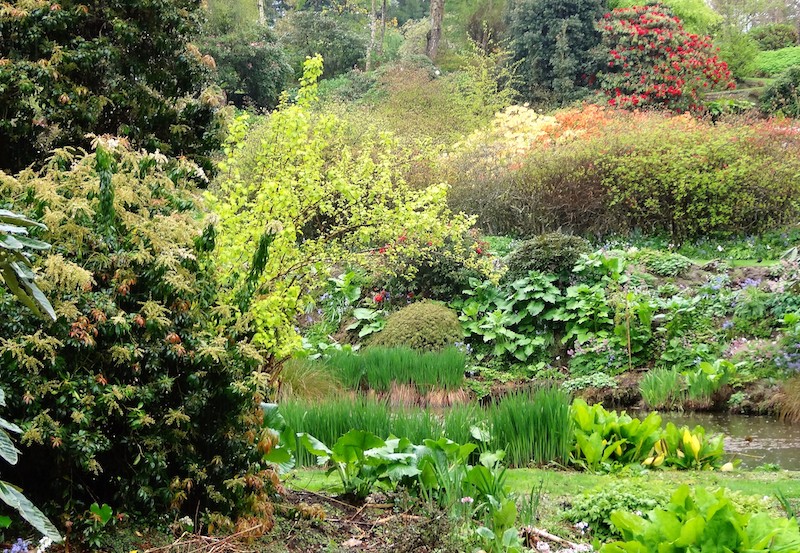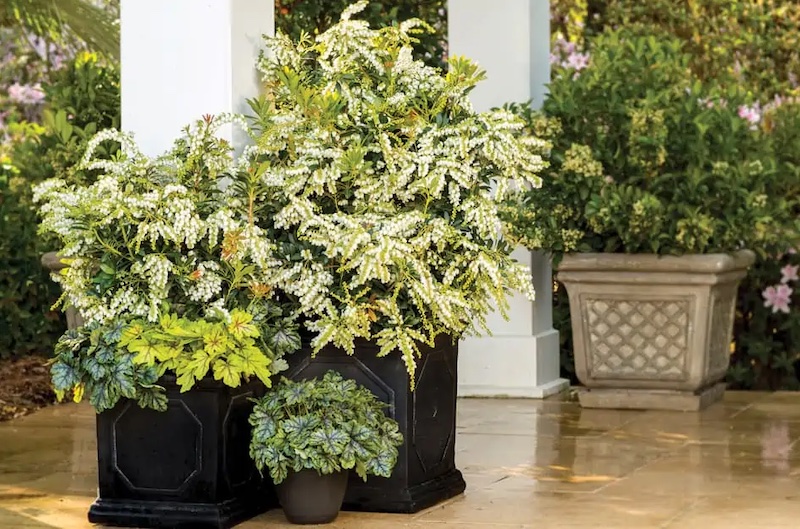Early spring blooming shrubs are a mainstay in most gardens and help to bring a sense of seasonality to the garden. The small blooms of pieris occur in large clusters and last throughout the spring. The new foliage growth comes out in various shades of red to contrast with the deep greens of the older growth, while the foliage turns sunset shades in the fall.
Pieris prefers acidic soil and full sun to part shade. Once established, it does not require much supplemental watering and rarely needs heavy pruning to keep a dense and compact shape. Broadleaf evergreens are valuable for bringing much-needed structure to the garden for 12 months of the year. Once the structure has been laid out, many plants can be successfully paired with Pieris when designing a garden border or informal hedge. Choosing the right plants will make the whole planting low maintenance and easy to care for for many years.

Photo by denisbin, cropped, Flickr, copyright CC BY-ND 2.0 DEED
Shrubs To Plant With Pieris
Pieris can be added to an evergreen shrub border or informal hedge and is at its best alongside other early spring blooming shrubs like azlaeas, camellias, rhododendrons, and star magnolias. The strong color of its foliage also works well in a foundation planting with pachysandra, hydrangea, holly, and viburnum shrubs. Planting pieris in partial sun and in soil in the acidic range will ensure the planting will thrive and require little maintenance.
Perennials To Plant With Pieris
Pieris can grow in either full sun or part shade, making them adaptable for mixed perennial and shrub borders. Shade lovers like ferns, hostas, tall garden phlox, astilbe, and heuchera can be planted in the shade of taller growing Pieris varieties. Pieris also looks good with early spring bloomers like primrose, snowdrops, crocus, English bluebells, and California poppies, which easily naturalize and form a dense ground cover. Pieris’ lovely foliage makes the perfect backdrop for medium-height perennials, such as cranesbill, lady’s mantle, kinnikinnick, and hellebore.
Annuals To Plant With Pieris
Annual plants are great to use while you are waiting for perennials to reach their full, mature size. They can be used to fill gaps with color and prevent annual weeds from taking hold in empty patches of soil. Select hardy annuals that will spread and bloom early in the season such as pansy, viola, primrose, and calendula. They will continue to bloom after pieris until the weather becomes hot in the summer. For later in the summer, plant pieris with snapdragons, dusty miller, petunias, and wax begonias. These annuals come in many colors and will appreciate the shade cast by pieris.
Best Companion Plants For Pieris in Containers
Dwarf varieties of pieris grow well with companions in containers on a deck or entryway. The best companions have shallow roots, like alyssum, lobelia, calibrachoa, and small spring bulbs. Plant pieris in the center of the arrangement with the smaller annuals and bulbs scattered organically around the edges.

Ensure that any container has sufficient drainage holes at the bottom and can be moved if needed during the winter months. Use a well-draining potting mix that has fertilizer formulated for acid-loving plants. Containers with a diameter of 18-20 inches or more can be planted with one pieris shrub and 3-4 filler/spiller plants.
Plants Not To Grow With Pieris
Pieris will not grow well in alkaline or constantly wet soil. Avoid growing it with plants that prefer a high pH such as lilacs, sedums, forsythia, weigela, and deutzia. Pond and boggy plants also do not make good companions. Pieris is liable to rot in soil that stays wet.
Best Plants To Grow With Pieris
In the landscape, use pieris as a backdrop for spring and summer annuals. Highlight its spectacular new spring growth with complementary or contrasting colors of early bulbs and annuals like pansies, violas, and primrose. Choose low-maintenance plants that do not require large amounts of fertilizing or supplemental watering to grow well through the summer.
 |
Author Robbin Small - Published 10-19-2023 |
